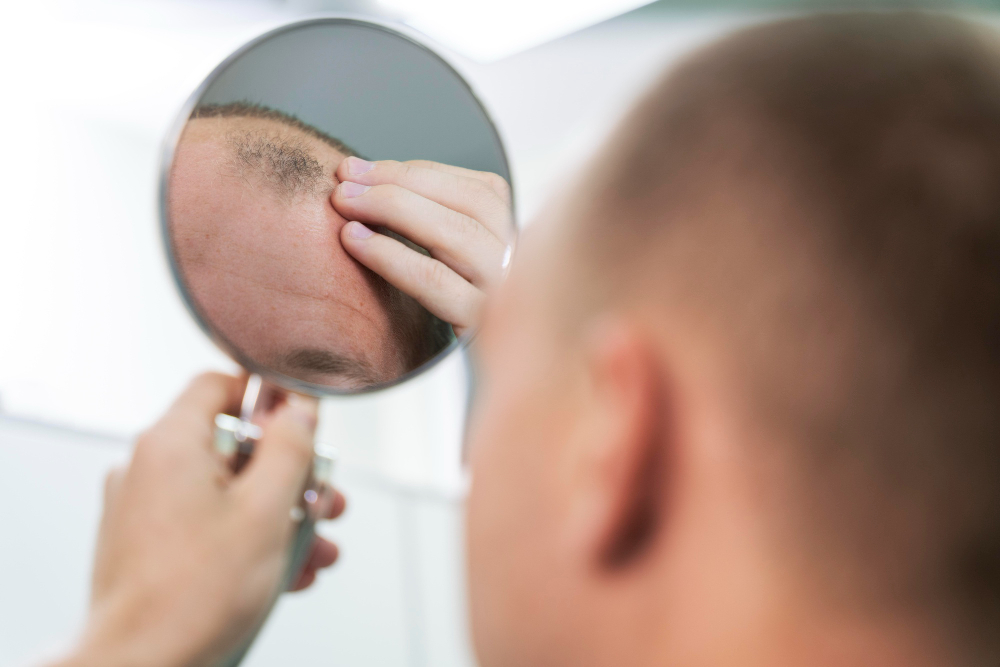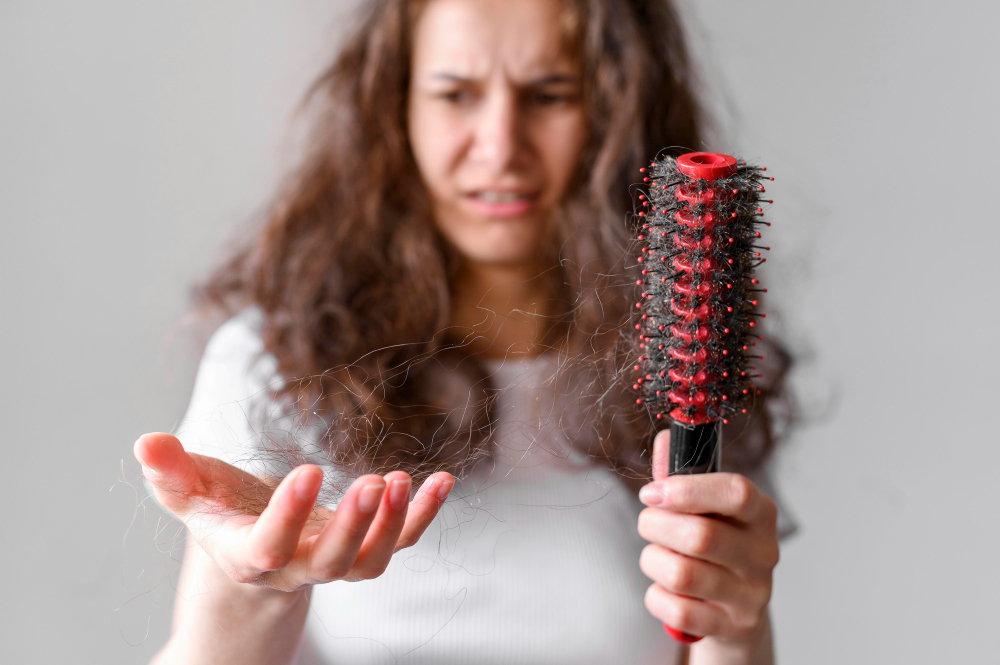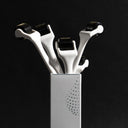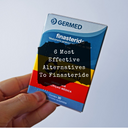Yeast infections on the scalp, caused by an overgrowth of fungi, can lead to uncomfortable symptoms such as itching, redness, and flaky skin.
Often stemming from factors like excessive oil production, weakened immunity, or antibiotic use, these infections disrupt the natural balance of microorganisms on the skin.
Recognizing symptoms early and understanding the causes are pivotal in seeking appropriate treatments.
Treatments range from medicated shampoos to antifungal medications to restore balance and alleviate discomfort.
This blog post delves into the symptoms, causes, and effective treatments for yeast infections on the scalp, offering insights for managing this condition.
Table of content
What is a yeast infection on the scalp?

A yeast infection on the scalp, often referred to as scalp ringworm or tinea capitis, is a fungal condition caused by an overgrowth of Malassezia yeast, a fungus naturally present on the skin. This imbalance leads to itching, redness, scaling, and sometimes hair loss.
It can affect individuals of any age and is often linked to an oily scalp, a weakened immune system, or the use of certain medications.
Yeast infections on the scalp occur when the naturally occurring yeast on the skin multiplies more than usual, disrupting the balance of microorganisms.
Factors contributing to this overgrowth, such as excessive sebum (oil) production on a scalp that isn't kept clean, humid environments, poor hygiene, or conditions that compromise the immune system, facilitate the thriving of Malassezia yeast.
The infection can cause discomfort and, if left untreated, may exacerbate skin diseases like follicular occlusion syndrome or lead to secondary infections, further affecting hair follicle health and exacerbating hair loss.
Treatment to treat scalp yeast infections typically involves antifungal medications or medicated shampoos designed to reduce yeast levels, remove dead skin, and alleviate symptoms, often requiring consistent application over several weeks to fully address the infection.
As your leading source for hair health information over the past 4 years, we never compromise on accuracy. When it comes to your health, you deserve information you can truly rely on - and earning your trust is our top priority.
Here's how Scandinavian Biolabs ensures every piece of content meets the highest standards of accuracy and integrity:
- Credentialed Experts: Our reviewers are actively practicing doctors and medical researchers
- Stringent Reviews: Content undergoes rigorous editing by subject specialists and review by a practicing doctor.
- Evidence-Based: We rely on well-established research from trusted scientific sources like peer-reviewed journals and health authorities.
- Full Transparency: Our editorial standards, writer credentials, reviewer credentials, correction process, and funding are all publicly documented.
- Independent Voice: While we do promote products, we operate in a vacuum to business operations. Our main goal is just an unwavering commitment to providing medically-sound guidance.
You can count on Scandinavian Biolabs to consistently deliver the trustworthy health information you deserve. Read our Editorial Standards.
What causes yeast infections on the scalp?

Yeast infections on the scalp are primarily caused by an overgrowth of the yeast fungus, which thrives in warm, moist conditions. This imbalance can be triggered by various factors, including:
- Excessive oil production: An oily scalp provides an ideal environment for yeast growth.
- Weakened immune system: Individuals with compromised immunity are more susceptible to infections, including yeast overgrowth.
- Use of antibiotics: Antibiotics can disrupt the natural balance of microorganisms on the skin, allowing yeast to proliferate.
- Poor hygiene: Infrequent washing or inadequate scalp care can encourage fungal growth.
- Humid environments: High humidity levels can increase scalp moisture, fostering yeast development.
- Underlying skin conditions: Conditions like seborrheic dermatitis can predispose individuals to yeast infections on the scalp.
Signs and symptoms of a scalp yeast infection
A scalp yeast infection can manifest through a range of discomforting symptoms characterized by irritation and visible changes to the scalp skin:
- Itching and soreness: One of the most common signs is itching, which can be relentless and lead to soreness from scratching. This constant need to scratch can aggravate the skin, leading to more severe symptoms.
- Red patches: These areas of redness may be slightly elevated and can spread if the infection worsens. The red patches and flaky scales often signal inflammation and irritation caused by the fungal overgrowth.
- Flaky skin: Resembling severe dandruff, flaky skin results from the scalp reacting to yeast overgrowth. These flakes can be white or yellowish; in severe cases, they can clump together, causing noticeable scaling.
- Oily scalp: Excessive oil production is both a cause and a symptom of yeast infections. The oiliness can worsen the condition by providing a conducive environment for yeast to thrive.
- Hair loss: While not always present, hair loss can occur in severe infections. The combination of inflammation, scratching, and damage to the scalp skin can weaken hair follicles, leading to temporary thinning or shedding.
- Blisters or bumps: In more severe cases, the infection can cause the development of small blisters or pimples. These can be painful and sign that the infection may require medical intervention to prevent further complications.
How do you treat a yeast infection on the scalp?

Treating scalp yeast infections involves using specific medications to eliminate the fungus and manage symptoms, along with home remedies that support recovery and comfort.
Medications and treatments
To effectively treat yeast infections on the scalp, healthcare providers may recommend a combination of medicinal treatments tailored to the severity of the yeast infection treatment itself.
Antifungal shampoos
Medicated shampoos are often the first line of defence, with formulations designed to target scalp fungal infection and reduce fungal growth.
Ingredients like ketoconazole, selenium sulfide, and zinc pyrithione not only help in controlling the yeast population but also assist in managing flakiness and itchiness.
Regular use, as per medical advice, is key to their effectiveness.
Topical antifungals
Topical treatments, including creams and lotions containing antifungal agents such as clotrimazole or miconazole, are applied directly to the yeast on the scalp itself.
These medications penetrate the skin to directly combat the yeast, relieving symptoms and aiding in healing.
Oral antifungals
In cases where the scalp fungus is particularly stubborn or has spread beyond the scalp, oral antifungals may be prescribed.
Drugs like fluconazole or itraconazole work systemically to eliminate the fungal infection from the inside out, offering an effective solution for more severe conditions.
Steroid treatments
Doctors may prescribe topical steroids for significant inflammation and discomfort to quickly reduce symptoms such as redness, swelling, and intense itchiness.
While steroids do not treat yeast infections, they can provide considerable symptomatic relief.
Home remedies
Alongside antifungal medication, certain home remedies can offer supportive care to soothe symptoms and foster a healthy scalp environment.
Tea tree oil
Tea tree oil, renowned for its natural antifungal and antibacterial properties, can be an effective adjunct treatment. Diluting a few drops in carrier oil before applying it to the scalp can help reduce fungal growth and soothe irritation.
Apple cider vinegar
With its natural acidity, apple cider vinegar can help restore the scalp's pH balance, creating an environment with less harsh chemicals conducive to yeast overgrowth.
Used as a diluted rinse, it can also aid in reducing itchiness and flakiness.
Coconut oil
Applying coconut oil directly to the scalp can moisturize and soothe the area, relieving dryness and scaling. Its mild antifungal properties may also help in controlling the yeast population.
Probiotics
Incorporating probiotics into one's diet or taking supplements can strengthen the immune system and potentially reduce the likelihood of serious fungal infections and overgrowth by maintaining a healthy balance of bacteria in the body, including the skin.
By combining medical treatments with supportive home remedies, individuals can effectively manage and overcome yeast infections on the scalp, restoring comfort and scalp health.
When to see a doctor?

It's important to see a doctor for a scalp yeast infection if over-the-counter treatments don't improve symptoms within a few weeks, if the infection worsens, or if you experience severe symptoms like significant hair loss, widespread redness, or fever.
Professional medical advice is crucial for proper diagnosis and to prevent complications.
If you're struggling with persistent symptoms that don't respond to initial self-care or over-the-counter remedies, it's time to consult a healthcare provider.
A doctor can offer a definitive diagnosis, possibly through a scalp examination or culture, to ensure the correct condition is treated.
They may prescribe stronger antifungal medications or investigate other underlying health issues contributing to the infection.
Early consultation can also help avoid complications such as secondary bacterial infections or permanent hair loss, ensuring a tailored and effective treatment plan.
How can a yeast infection on the scalp be prevented?
Preventing a yeast infection on the scalp involves maintaining a healthy scalp environment and adopting habits that reduce the risk of fungal overgrowth:
- Maintain scalp hygiene: Maintaining a scalp clean through regular washing with a mild shampoo helps keep oil production in check and removes potential fungal growth media, reducing the risk of tinea capitis.
- Use antifungal products occasionally: Incorporating antifungal shampoos or products into your routine can prevent yeast proliferation.
- Keep the scalp dry: After washing your hair, thoroughly dry your scalp to reduce moisture, which fungi thrive on.
- Manage stress: Stress can impact your immune system, so managing stress through relaxation techniques or exercise can help maintain your body's natural defense against infections.
- Eat a balanced diet: A diet rich in fruits, vegetables, and whole grains can support a healthy immune system and reduce the risk of infections.
- Avoid sharing personal items: Hats, brushes, and other personal items can carry fungi, so avoid sharing them to prevent cross-contamination.
Can a scalp yeast infection cause hair loss?

Yes, a scalp yeast infection can cause hair loss. The infection may lead to inflammation and scalp irritation, disrupting the hair follicles and potentially resulting in temporary hair thinning or loss.
When a yeast infection occurs on the scalp, the associated symptoms, such as itching, redness, and scaling, can significantly affect the health of the hair follicles.
The constant urge to scratch can mechanically damage hair follicles, leading to hair breakage and loss.
Additionally, the inflammatory environment created by the fungal overgrowth can interfere with the normal hair growth cycle, causing hairs to enter the shedding phase prematurely.
While the hair loss associated with most scalp yeast infections is typically temporary, addressing the infection promptly with appropriate treatment is crucial to minimize impact and encourage healthy hair regrowth.
Conclusion
In conclusion, scalp yeast infections can be troublesome, manifesting through symptoms like itching, redness, and flaking and potentially leading to hair loss.
Key factors contributing to these infections include excessive oil production, weakened immunity, and environmental conditions conducive to yeast overgrowth.
Effective treatments range from medicated shampoos and antifungal medications to home remedies that support a healthy scalp environment. Preventative measures are crucial for maintaining scalp health and avoiding scalp infections.
Within this landscape, Bio Pilixin Serum stands out as a potent, nature-inspired solution to support scalp health and combat hair issues related to yeast infections.
Its innovative formula, enriched with Capilia Longa, Niacinamide, and Vanillyl Butyl Ether, targets the essential aspects of scalp care, fostering an environment that promotes hair health and density.
The serum's positive user feedback, coupled with a 150-day money-back guarantee, underscores its effectiveness and the brand's confidence in its ability to deliver tangible results.
FAQs
Can scalp yeast infections cause permanent hair loss?
While a scalp infection caused by yeast infections can lead to temporary hair thinning or loss, the condition typically does not cause permanent hair loss. Effective treatment and scalp care can help to regain hair density.
How often should I use medicated shampoos for a yeast infection?
The frequency of medicated shampoo use should follow the recommendation of a healthcare provider, but it's commonly advised to use these shampoos two to three times a week until symptoms improve.
Can lifestyle changes help prevent scalp yeast infections?
Yes, lifestyle changes such as maintaining good scalp hygiene, managing stress, eating a balanced diet, and avoiding humid environments can help prevent yeast infections on the scalp.
References
- https://www.ncbi.nlm.nih.gov/pmc/articles/PMC8808739/
- https://www.ncbi.nlm.nih.gov/pmc/articles/PMC7522433/
- https://pubmed.ncbi.nlm.nih.gov/33061509/
Read more:







